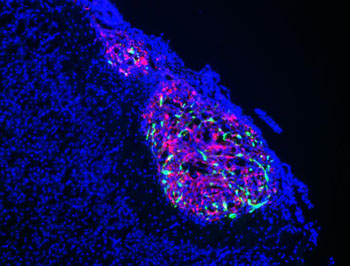Novel Gene Therapy Approach Kills Glioblastoma Tumors In Vitro and In Vivo
By LabMedica International staff writers
Posted on 31 May 2016
Gene therapy to increase expression of the enzyme Emx2 (Homeobox protein Emx2) in glioblastoma multiforme (GBM) tumor cells was shown to destroy the cancer in vitro and prevent its recurrence in vivo.Posted on 31 May 2016
GBM is the most common primary tumor of the central nervous system and is almost always fatal. The aggressive invasion of GBM cells into the surrounding normal brain makes complete surgical removal impossible, significantly increases resistance to the standard therapy regimen, and virtually assures tumor recurrence. Median survival for newly diagnosed GBM is 14.6 months and declines to eight months for patients with recurrent GBM.

Image: A fluorescent micrograph of glioblastoma cells (Photo courtesy of the International School of Advanced Studies).
Investigators at the International School of Advanced Studies (Trieste, Italy) had been studying Emx2 for several years and had found that it was expressed at very high levels during embryonic neuronal generation, but that its action declined dramatically when glial cells started to grow. As GBM tumors share many features with astroglia, the investigators looked at the possibility that elevated Emx2 activity might inhibit GBM growth.
Towards this end, they developed a viral carrier to transfect GBM cells with the EMX2 gene, which would engineer the production of the Emx2 enzyme inside the cancer cells. They reported in the May 13, 2016, online edition of the journal Oncotarget that Emx2 overexpression induced the collapse of seven out of seven in vitro tested glioblastoma cell lines. Moreover, it suppressed four out of four of these lines in vivo. As proven by dedicated rescue assays, the anti-oncogenic activity of Emx2 originated from its impact on at least six metabolic nodes, which accounted for the robustness of its effect.
"The treatment targeted may points of the tumor process, so there are good chances of effectively contrasting the development of aggressive recurrences," said senior author Dr. Antonello Mallamaci, associate professor of molecular biology at the International School of Advanced Studies. "For these to form, there has to be a process of selection of the strongest tumor cells. By targeting them at a variety of different points, we raise the standards in this selection process and - hopefully - we prevent the recurrences. Now we plan to extend the in vivo tests to other glioblastomas. With a lot of hard work and a bit of luck we hope that in a few years' time all this can translate into a tangible benefit for the unfortunate patients afflicted by this disease."
Related Links:
International School of Advanced Studies














